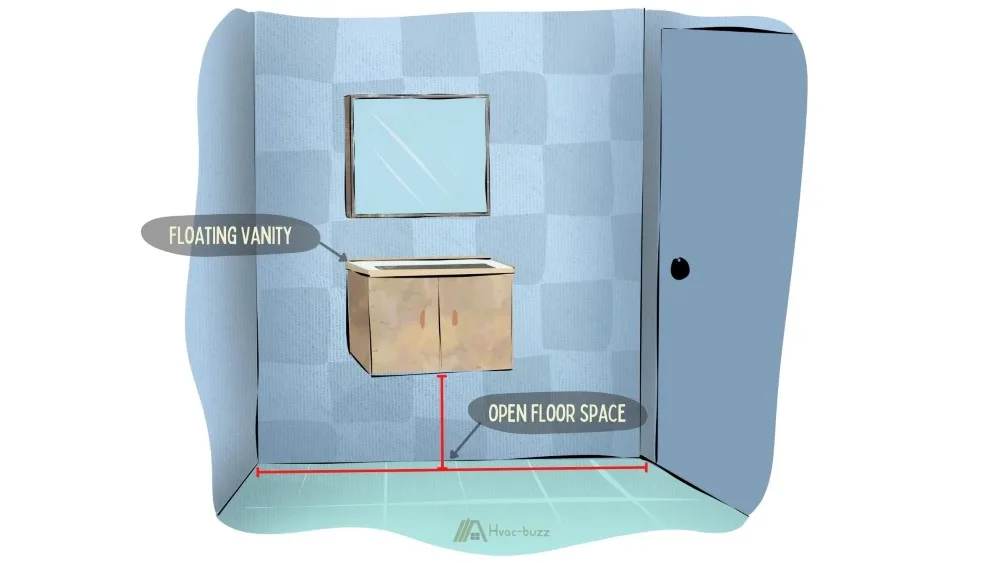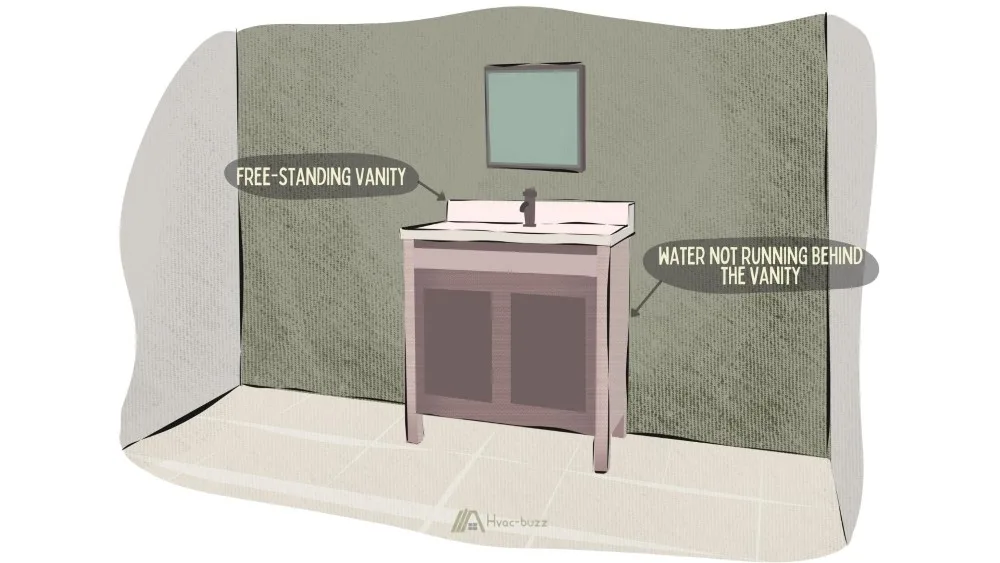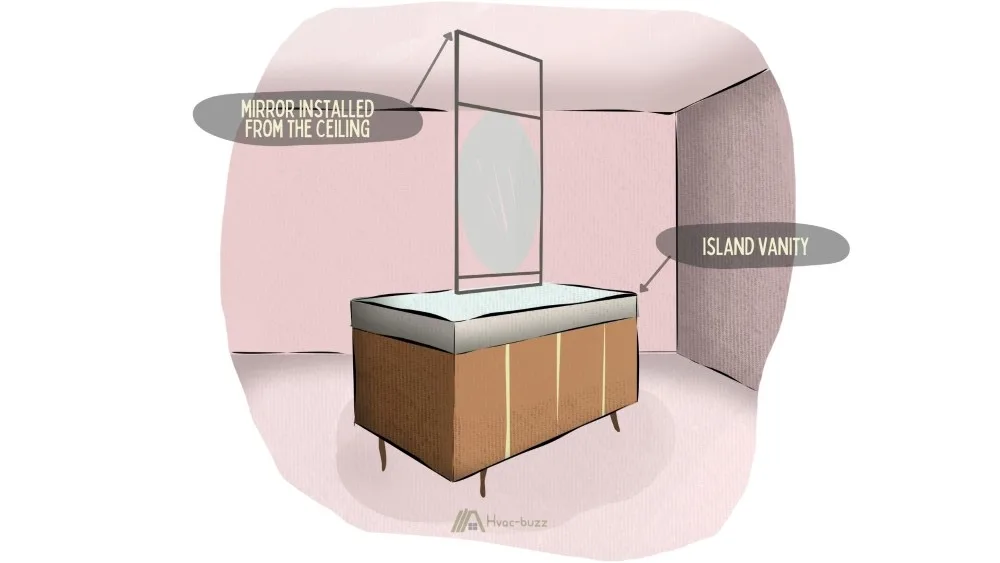Bathroom vanities are effective at keeping your bathroom organized, and some can even create unique design elements. With the variety available, whether you’re looking for functionality or wow-factor, you will definitely be spoilt for choice. However, there is also the practical consideration of choosing a vanity: how to install it. I’ve said it before and I think I’ll be saying it forever, but you become the most detail-orientated person when you are remodeling!
The majority of vanities you see are attached to the wall. It is much more common to see a free-standing pedestal sink. This begs the question, is it a rule or best practice to attach the vanity to the wall? Are there reasons that so many people are doing it? What are the benefits of detached vanities? Well, I’m not about to leave you with more questions than you started with, so let’s talk about your vanity installation options.

Bathroom vanities do not have to be attached to the wall, but this can reduce the risk of pressure being put on the wall-hung plumbing, which is an IRC regulation. Attached vanities are more secure and water is less likely to run behind it. Detached vanities are easier to clean behind and often cheaper.
Wall-Hung Plumbing Must Be Stable
It is extremely common to have your plumbing coming from the wall. It is easier to install your bathroom basin this way and you can avoid having unsightly pipes appearing underneath your vanity.
However convenient this may be, there are also risks involved. If your vanity is really heavy and is leaning on the plumbing, you may have an issue on your hands as the added strain could cause the pipes to crack. As long as you follow these regulations set out by the International Residential Code (IRC), you will be good to go.
Section P2705.1 of IRC outlines that as long as your vanity is stable and does not put direct pressure on the plumbing, then you are not contravening any rules or regulations.
Beyond this, there don’t seem to be any codes pertaining to attaching vanities to walls (or not), which means that it comes down to user choice, which is, in turn, dependent on factors like your preference, the setup of your bathroom and plumbing, the style and dimensions of your vanity, etc.
I’m a firm believer in lists, so let’s go through the pros and cons of attaching your vanity to the wall and the pros and cons of having a free-standing vanity.
Should You Attach the Vanity to the Wall?
Pros
- Accessing pipes through walls is so much simpler than accessing them through the floor, which, in a bathroom, is almost always tiled. To ensure that the abovementioned code is complied with, many vanities that are not attached to the wall will have floor-based basin plumbing. Vanities attached to walls can be plumbed through the wall.
- Most bathroom vanties are designed to be set up against a wall and the common assuption is that they will be attached to the wall itself. From a manufacturing perspective, this makes the addition of a back panel a needless expence. Attaching your vanity to the wall ensure that there is no chance of the unit slipping forward and all your carefully stored items falling out down the back.
- If your bathroom floor slopes for whatever reason, you can avoid having to make adjustments to the length of the vanity’s legs by simply opting for a floating vanity that attaches directly and levely to the wall and give the impression that all is well with the angle of your bathroom floor.
- There is no denying that attaching your vanity to your wall provides stability to the whole unit and everything in it. There is no chance of it slipping or tipping, even if you have a toddler hanging from the counter at one end. To some, this safety benefit outweighs any pros that a detached vanity provides.
- When a vanity is attached to a wall, the edge can be sealed wiht caulk. Without this, water would be able to get behind the unit and cause all kinds of issues like rot, mold, warping, etc.
- An attached vanity can be the perfect choice for a small bathroom as you can opt for a floating vanity, which doesn’t use up floor space.

Cons
- Vanities attached to walls are harder to remove during a remodel. You have to unseal it and unstick it, deal with screws and holes in the walls, etc.
- If not properly sealed, then water can easily get behind the vanity, but you cannot deal with the moisure without climbing into the vanity cupboard or removing the unit from the wall.
- Installation of an attached vanity is considered to be more complex, and, as we know, in the construction/remodeling world, complexity equals cost.
- For some reason, with these vanities, the countertops are usually sold separately, which also increases costs.
Detached Vanities
Pros
- Detached vanities are a lot easier to remove when needed during a repair or remodel. The mobility (which will be limited depending on the nature of the plumbing, also makes it easier to clean behind the vanity.
- The styles associated with detached vanities tend to be those that are a bit more modern that those used with attached vanities.
- Detached vanities can be cheaper to buy and the counter will always come attached to it.
- Installation is also often easier, which equates to be less expensive.

Cons
- These vanities can wobble and shift without the stabilization of the wall, particularly if you put too much weight on them. This is not just annoying. It can be hazardous to your, your families, your pets, and your pipes.
- Even though the gap behind the vanity is easier to clean, the fact that the vanitiy does not sit flush against the wall means that dirt is more likely to accumulate there.
- Things can fall off the vanity and get lost behind it.
- If you don’t have a lip at the back of the vanity, then water can easily run down the back causing mold, warping, rot, etc.
- Free-standing vanities have back panels, which means that weather you are plubing from underneath or behind, you will need to make alterations if there are no holes cut out for this purpose.
Solutions to Gap Between Vanity and Wall
When your vanity is not attached flush against the wall, there is usually a gap between the two, in order to accommodate the plumbing.
One way to rectify this is by over-extending your countertop right to the wall to prevent any water or dirt from falling through the gap. Alternatively, you can also add a bit of trim to the edge of the countertop.
If the gap is relatively small, only a couple of inches, then you can simply use a silicon caulk to seal it (although this eliminates your ability to move it and clean behind it). If it is slightly larger, then it is recommended to install a backer rod to the vanity.
If there is space on either side of the vanity, you can definitely utilize this space for storage. If it is large enough, you can place your laundry basket there, but if it is on the smaller side you can install short shelves in that space and store smaller items such as a spare hand towel, extra roll of toilet paper, or other odds and ends.
Modern Option: Island Vanities
Island vanities are definitely a lot rarer in bathrooms today. This type of vanity is unique in that they are usually found in the center of the bathroom with two or more sinks facing each other on either side of the vanity.
This type of island is truly a dream, much like an island you’d get in your kitchen. However, it is not for everyone.

Firstly, you will really need a lot of space in your bathroom if you want one of these. They definitely won’t suit a small one-bedroom apartment where your closet and bathroom are similar in size.
Then you get the added stress of the huge plumbing job that comes along with it. In these cases, the plumbing is coming from underneath the floor as opposed to the wall, which might cost you a pretty penny for installation as your floor will need to be dug up in order to expose and install pipes.
Putting those cons aside, if you are lucky enough to have a spacious and luxurious bathroom, then maybe consider adding one of these to your home, with a great, hanging mirror. You will definitely be the talk of your neighborhood.
Sources
https://www.apartmenttherapy.com/bathroom-trends-bathroom-island-vanities-256704
https://homedecorbliss.com/should-bathroom-vanity-be-against-wall/
https://yourniftyhome.com/bathroom-vanity-flush-or-attached-to-wall/
https://www.hunker.com/13725684/freestanding-bathroom-vanity-what-you-should-know
